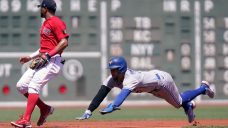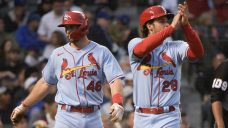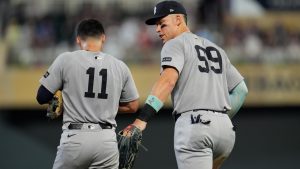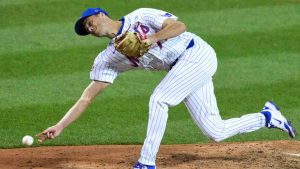TORONTO – With eight days remaining before the 2022 trade deadline, the Toronto Blue Jays have a chance to improve their roster on a couple of fronts.
Like all teams, the Blue Jays would be better off with Juan Soto in their lineup. Any GM who’s serious about winning should explore trades for Soto, who has already established himself as a Hall of Fame type talent at age 23. But many teams covet Soto and only one can have him. It’s far more likely that the Blue Jays will pursue and acquire pitching.
That’s all stating the obvious, though. To better understand the opportunities in front of the Blue Jays, let’s attempt to establish their needs as precisely as possible. By seeing what it is they lack, we can better position ourselves to anticipate their next steps…
THE LATE-SUMMER PROBLEM: CLINCHING
Objectively speaking, the Blue Jays are likely to reach the post-season thanks to a 53-43 record that has them in the AL's top wild-card spot. They aren’t there yet, though, and a deeper starting rotation would help turn that likelihood into reality.
Maybe Yusei Kikuchi gets his season back on track. Maybe Max Castillo emerges as a capable back-end starter. Do you want to rely on those things happening, though? And potentially exhaust your bullpen along the way?
Better to add a starting pitcher now, especially because there’s no late-August waiver trade deadline anymore. If you want to acquire help, this is the time.
Because Alek Manoah, Kevin Gausman and Jose Berrios could all be trusted to start playoff games, the Blue Jays aren’t lacking frontline arms. With that in mind, they should determine the availability of pending free agents like Martin Perez, Jose Quintana, Drew Smyly, Chad Kuhl, Noah Syndergaard, and Zack Greinke. It’s not the most exciting group, but it doesn’t have to be.
While Perez and Quintana likely have some real trade value, history tells us that veteran pitch-to-contact types simply don’t command big hauls at the deadline (even Syndergaard, the hardest thrower of this group and someone the Blue Jays pursued last winter, has a below-average strikeout rate). Of the pitchers listed above, Perez may be the best fit as he’s a ground ball pitcher who commands the strike zone reasonably well (14.2 per cent K-BB%).
Regardless, adding a pitcher from this cohort would address a need at the big-league level without meaningfully depleting Toronto’s prospect ranks.
THE EARLY OCTOBER PROBLEM: POWER RELIEF
It's Sunday, Oct. 9, and you’re playing Game 3 of the Wild Card series at Tropicana Field. With your season on the line, Berrios gives you five-plus solid innings, but runners are on the corners now and it’s time to bail him out of the sixth inning. You need strikeouts. Who’s pitching?
Based on the current roster, John Schneider is probably calling on David Phelps (21.9 per cent K-rate), Adam Cimber (19.8 per cent K-rate) or Tim Mayza (20.5 per cent K-rate), but all three have below-average strikeout rates compared to the MLB relief average of 23.5 per cent. Season on the line, you have to equip Schneider with better options. Because even if the above scenario is obviously a hypothetical, these situations will come up if the Blue Jays are going to play in – and win – four playoff rounds.
Last year, the Blue Jays took a bulk approach to the bullpen, adding Cimber, Trevor Richards, Brad Hand and Joakim Soria. But quantity did not equate to quantity, and the need for high-leverage relief help persisted. Adding Yimi Garcia helped, as he looks like a viable candidate for season-on-the-line relief work, but the Blue Jays hoped others would emerge internally only to see Nate Pearson and Julian Merryweather have their seasons derailed by injuries.
Now, the need for relief remains as glaring as ever, and this time the Blue Jays must prioritize quality, even if that means paying a higher price. Yes, shopping for something as inherently volatile as relief pitching can backfire, but not adding relief would be an even riskier choice for a team with so much potential.
Among the relievers worth investigating further: Gregory Soto and Joe Jimenez of the Tigers, Joe Mantiply of the Diamondbacks, Jorge Lopez of the Orioles, David Robertson of the Cubs, A.J. Puk of the A’s, Kyle Finnegan of the Nationals, Scott Barlow of the Royals, David Bednar of the Pirates, Matt Bush of the Rangers and Anthony Bass of the Marlins.
The Blue Jays wouldn’t have to give up their very best prospects to shop in this tier (especially for Robertson, a rental), but if they have to give up some intriguing talent to add here, so be it. And realistically, the Blue Jays would be better off with multiple arms from this group.
THE SMALL-SCALE PROBLEM: THE BENCH
A month ago, the bench looked like a bigger concern but as Raimel Tapia and Cavan Biggio have played better, the need for an established left-handed or switch-hitting bat along the lines of Ian Happ has started to seem more like a luxury. This may nudge the Blue Jays to prioritize other needs, but it’s always worth exploring upgrades, no matter how small. Expect the bench to be on their radar, too.
Some possibilities to consider: is there a centre fielder who can spell George Springer nearly as well as Bradley Zimmer while providing more offence than the current backup? Is there a lefty bat who can offer more offence than Zack Collins? Or comparable offence with more defensive value?
THE 2023 PROBLEM: MORE ARMS NEEDED
So far, the needs we’ve examined cover the 2022 season, but since Hyun-Jin Ryu will likely miss all of next year and Kikuchi’s something of an unknown as well, there’s also a case to be made for adding a pitcher with multiple years of control.
Pursuing Reds trade candidate Luis Castillo makes sense even if the acquisition cost is much greater than it would be for, say, Quintana. Along those lines, it’s worth asking the Marlins about Pablo Lopez and others. Maybe the price is prohibitively high, in which case the Blue Jays don’t need to act desperately, but there could be an opportunity here, too.
Last summer’s deal for Berrios showed the Blue Jays aren’t opposed to this type of trade under the right circumstances. Starting here makes sense and if it doesn’t work out, a short-term fallback starter could still help this team reach the 2022 playoffs. And either way: the Blue Jays' front office must add impact relief for the deadline to be a clear success.






